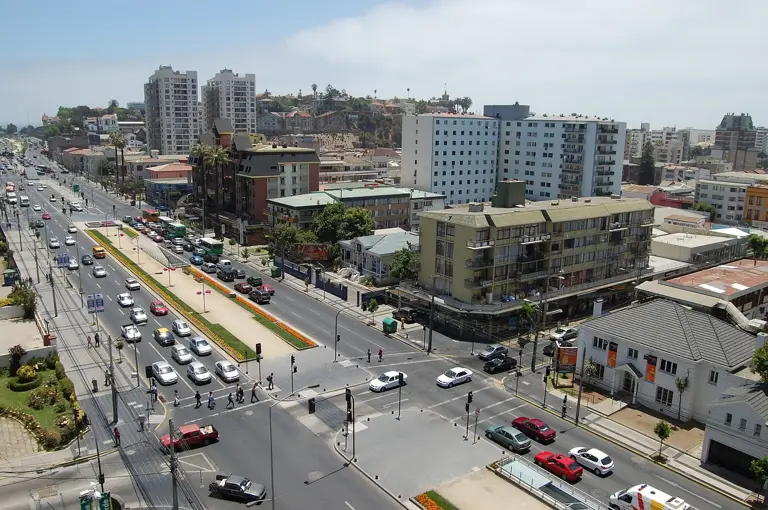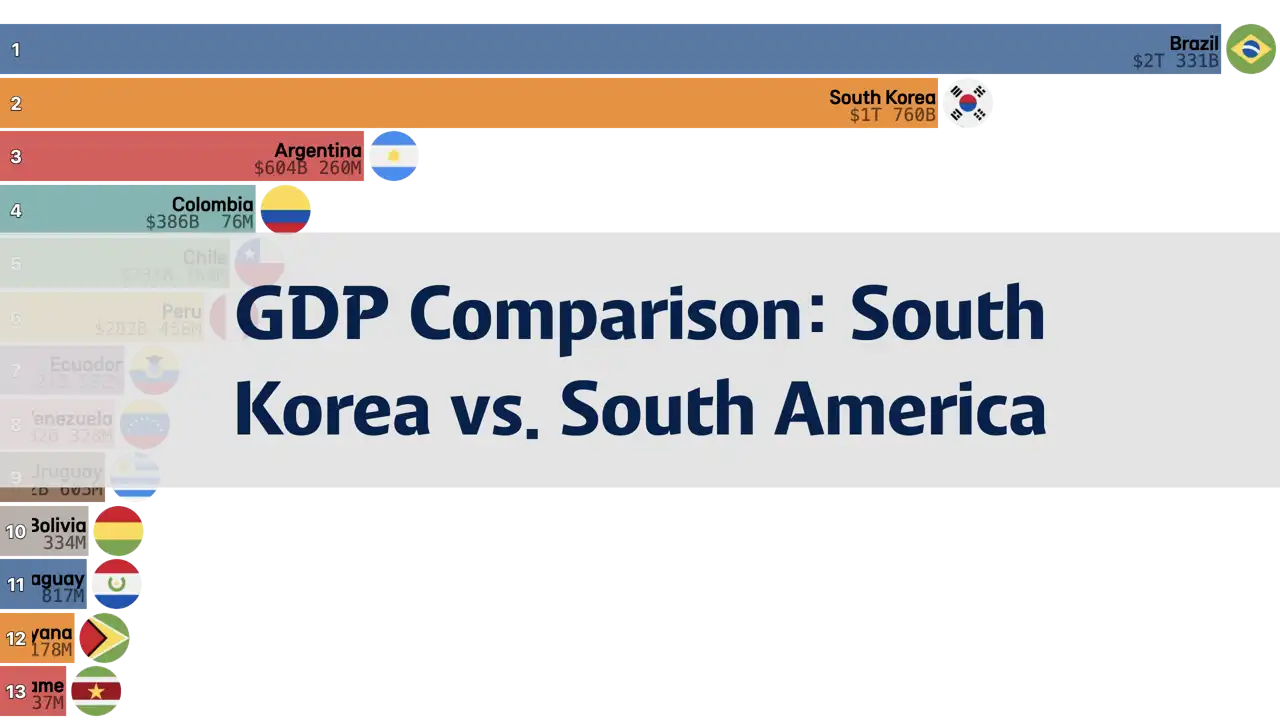
Comparing the GDP of South Korea and South American Countries in 2023
- ASUMUP
- Economy
- August 18, 2024
The global economy is a complex and interconnected system, where countries across continents are compared in terms of economic output. In 2023, South Korea and several South American countries presented a fascinating comparison, particularly in terms of Gross Domestic Product (GDP). While geographically distant, South Korea and South American nations like Brazil, Argentina, and Colombia share certain economic interactions and differences that are worth exploring.
South Korea stands out as an advanced economy with a high GDP relative to its population size and geographic area. In contrast, South America, with its diverse range of economies, showcases varying degrees of development and economic output. This post will delve into how South Korea's economy compares to that of the leading South American nations, examining the factors that contribute to their GDPs and the implications of these figures on the global economic landscape.
From the technological prowess of South Korea to the resource-rich economies of Brazil and Argentina, each country brings unique strengths and challenges to the table. This comparison not only highlights the economic disparities but also emphasizes the potential for collaboration and growth between these regions.
South Korea vs. South America's GDP Showdown!
- 1st Brazil - $2.2 trillion
- 2nd Argentina - $654.9 billion
- 3rd Colombia - $363.6 billion
- 4th Chile - $335.7 billion
- 5th Peru - $267.6 billion
- 6th Ecuador - $120.2 billion
- 7th Venezuela - $97.1 billion
- South Korea - $1.7 trillion
South Korea - $1.7 trillion
In 2023, South Korea’s GDP was approximately $1.7 trillion, placing it second in this comparison of South Korea and South American countries. South Korea's economy is driven by advanced technology, robust manufacturing sectors, and a strong export-oriented strategy. The country has established itself as a global leader in industries such as electronics, automotive, and shipbuilding, with companies like Samsung, Hyundai, and LG playing pivotal roles. While South Korea's economy is smaller than Brazil's, the largest in South America, it significantly surpasses the GDP of other South American nations, showcasing its economic strength and influence on the global stage.
The economic relationship between South Korea and South America is characterized by increasing trade, investment, and cooperation in various sectors. South Korea's demand for raw materials, particularly from resource-rich South American countries like Brazil, Argentina, and Chile, has fostered stronger ties. Conversely, South Korea exports technology and manufactured goods to these nations, creating a mutually beneficial economic relationship. This interaction not only helps South American economies diversify but also reinforces South Korea's position as a key economic player in the global market.
7th Venezuela - $97.1 billion
Venezuela, with a GDP of approximately $97.1 billion in 2023, is the eighth-largest economy in this comparison. The Venezuelan economy has historically been dominated by its oil industry, which once made it one of the wealthiest countries in South America. However, political instability, economic mismanagement, and international sanctions have led to a dramatic decline in the country's economic fortunes.
The ongoing crisis in Venezuela has resulted in hyperinflation, a collapsing infrastructure, and widespread poverty. Compared to South Korea, Venezuela's economy is in a state of severe contraction, with limited prospects for recovery under the current conditions. The contrast between Venezuela's potential and its current reality underscores the impact of governance and policy on economic outcomes.
6th Ecuador - $120.2 billion
Ecuador, with a GDP of approximately $120.2 billion in 2023, is the seventh-largest economy in this comparison. The Ecuadorian economy is heavily dependent on oil exports, which are the primary source of revenue for the country. In addition to oil, Ecuador has a significant agricultural sector, producing bananas, shrimp, and cocoa, which are important export products. The country also has a growing services sector, particularly in tourism, which capitalizes on its unique natural environments such as the Galápagos Islands.
However, Ecuador faces economic challenges, including dependency on oil, political instability, and limited industrial diversification. Compared to South Korea, Ecuador's economy is much smaller and less diversified, with a greater reliance on natural resources. Nonetheless, Ecuador continues to seek ways to diversify its economy and improve its economic stability.
5th Peru - $267.6 billion
Peru, with a GDP of approximately $267.6 billion in 2023, ranks sixth in this comparison. The Peruvian economy is primarily driven by mining, particularly copper, gold, and silver, which are significant contributors to its GDP and export revenues. Additionally, Peru has a growing agricultural sector, known for its exports of asparagus, coffee, and quinoa. The country also benefits from a burgeoning tourism industry, supported by its rich cultural heritage and natural wonders such as Machu Picchu.
Despite these strengths, Peru faces challenges related to poverty, inequality, and infrastructure development. The economy is also vulnerable to fluctuations in global commodity prices, which can impact growth. Compared to South Korea, Peru's economy is smaller and more reliant on natural resources, but it has shown resilience and potential for growth through diversification and reforms.
4th Chile - $335.7 billion
Chile, with a GDP of approximately $335.7 billion in 2023, is recognized for its stable and well-managed economy, making it the fifth-largest in this comparison. Chile's economy is heavily reliant on copper exports, as the country is the world's largest producer of this essential metal. Copper plays a crucial role in Chile's trade and government revenues, contributing to its strong economic performance. In addition to mining, Chile has a well-developed agricultural sector, producing fruits, wine, and seafood for export, along with a growing services sector.
Chile's economy, while relatively small, is considered one of the most stable and prosperous in South America. Its sound macroeconomic policies and open trade regime have helped sustain growth and attract foreign investment. Compared to South Korea, Chile's economy is less diversified and more dependent on a single commodity, but it remains a key player in the South American region with a strong track record of economic management.
3rd Colombia - $363.6 billion
Colombia, with a GDP of approximately $363.6 billion in 2023, stands as the fourth-largest economy in this comparison. The Colombian economy is primarily driven by its rich natural resources, including oil, coal, and coffee. The country is one of the world’s top coffee producers and a significant exporter of oil and coal, which form the backbone of its export economy. Additionally, Colombia has a growing services sector, particularly in finance, tourism, and information technology, which has helped diversify its economy.
However, Colombia also faces challenges such as internal conflict, inequality, and reliance on commodity exports, which can be volatile. Compared to South Korea, Colombia’s economy is smaller and more resource-dependent. Nevertheless, Colombia's economic growth potential remains strong, supported by ongoing reforms and efforts to improve security and infrastructure.
2nd Argentina - $654.9 billion
Argentina, with a GDP of approximately $654.9 billion in 2023, ranks as the third-largest economy in this comparison, following Brazil and South Korea. Argentina's economy is diverse, with significant contributions from agriculture, manufacturing, and services. The country is a major producer of soybeans, corn, and wheat, and has a well-developed industrial base, particularly in automobiles and food processing. Argentina's economy also benefits from a highly educated workforce and a rich cultural heritage that supports its tourism sector.
Despite these strengths, Argentina faces significant economic challenges, including high inflation, external debt, and periodic financial crises. These issues have led to economic instability and hindered long-term growth. When compared to South Korea, Argentina's economy is much smaller and less stable, but it remains one of the most important economies in South America, with a strong potential for recovery and growth if structural reforms are implemented.
1st Brazil - $2.2 trillion
Brazil, with a GDP of approximately $2.2 trillion in 2023, is the largest economy in South America and surpasses South Korea by a notable margin. Brazil’s economy is heavily reliant on its vast natural resources, including minerals, agriculture, and energy. The country is one of the world’s leading exporters of soybeans, iron ore, and oil, making it a critical player in global commodity markets. Additionally, Brazil's large and diverse population fuels a significant domestic market, which supports industries ranging from manufacturing to services.
However, Brazil faces challenges such as income inequality, political instability, and infrastructure deficits, which can hinder its economic growth. In comparison to South Korea, Brazil’s economy is less technologically advanced and more vulnerable to fluctuations in global commodity prices. Despite these challenges, Brazil's economic size and resource base give it a significant role in the global economy, particularly in the context of South America.
Other Posts in the Economy
Categories
- National Rankings(43)
- Science & Technology(1)
- Sports(24)
- Economy(30)
- Society(12)
- Culture(7)
Recent Posts
![Bayern Spent HOW MUCH on Harry Kane?! Ranking Their Top 10 Biggest Signings Ever]() A deep dive into Bayern Munich's ten most expensive transfers, exploring how the club's spending strategy has evolved to chase European glory.
A deep dive into Bayern Munich's ten most expensive transfers, exploring how the club's spending strategy has evolved to chase European glory.![Arsenal's Record-Shattering Spree: From a €116M Gamble to a Flop, Who Was Worth the Cash?]() A deep dive into Arsenal's top 10 most expensive signings, analyzing the successes, the failures, and the massive fees that have defined the club's modern transfer strategy.
A deep dive into Arsenal's top 10 most expensive signings, analyzing the successes, the failures, and the massive fees that have defined the club's modern transfer strategy.![Chelsea Cashes In BIG TIME! Who Really Won the 25/26 Summer Transfer Window Money Game?]() A deep dive into the top 10 clubs that made the most money from player sales during the wild 25/26 summer transfer window.
A deep dive into the top 10 clubs that made the most money from player sales during the wild 25/26 summer transfer window.![Liverpool's Record-Breaking €483M Spree! Did They Just Buy the Premier League Title?]() A deep dive into the 25/26 summer transfer window reveals Liverpool's record-breaking spending spree as Premier League clubs continue to dominate the market.
A deep dive into the 25/26 summer transfer window reveals Liverpool's record-breaking spending spree as Premier League clubs continue to dominate the market.![You Won't Believe How Much a Loaf of Bread Costs in These Countries! (Spoiler: It's INSANE)]() This post explores the top 10 countries with the most expensive bread, revealing how factors like import reliance and tourism dramatically inflate the cost of this basic staple.
This post explores the top 10 countries with the most expensive bread, revealing how factors like import reliance and tourism dramatically inflate the cost of this basic staple.














